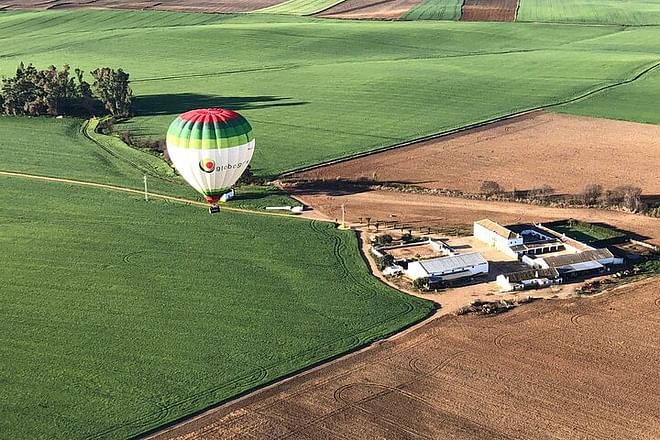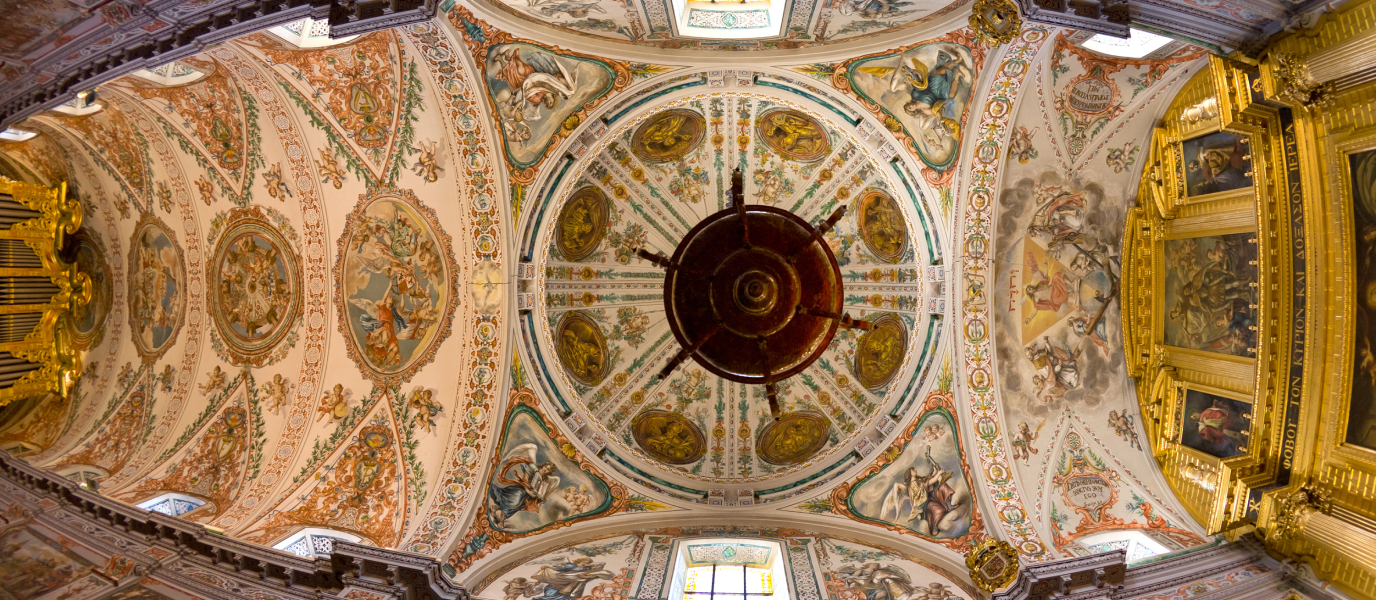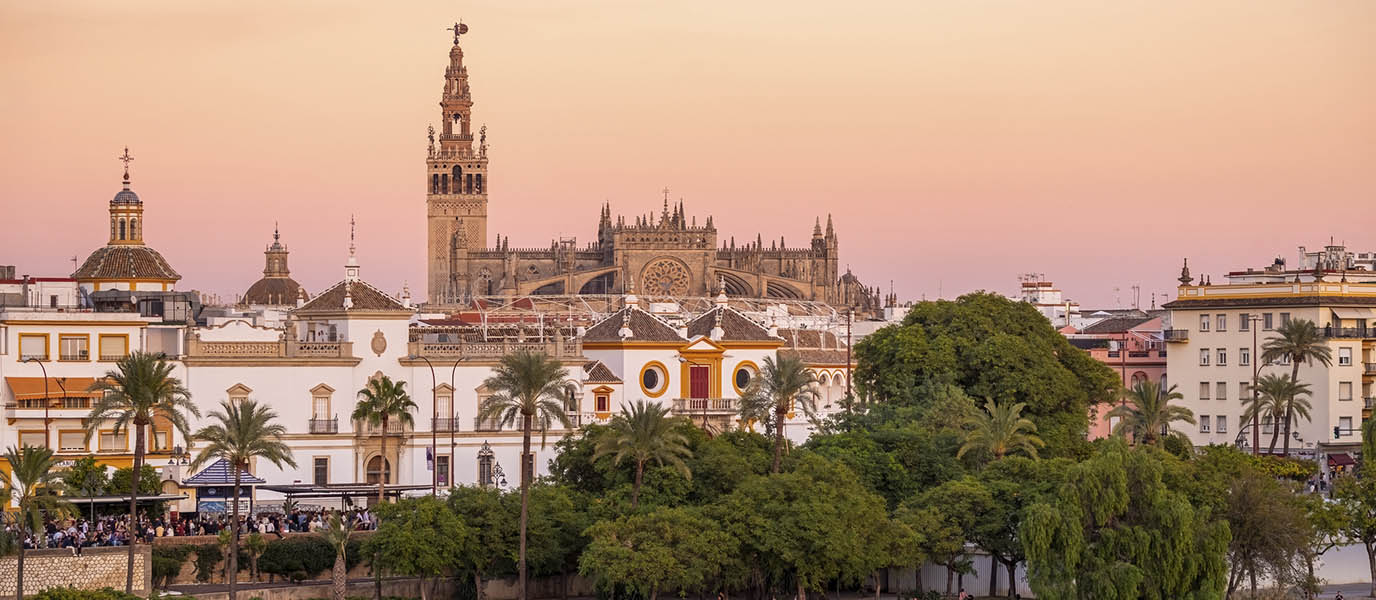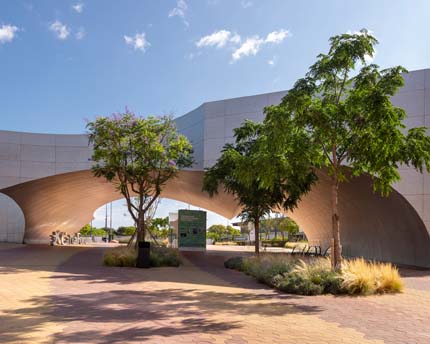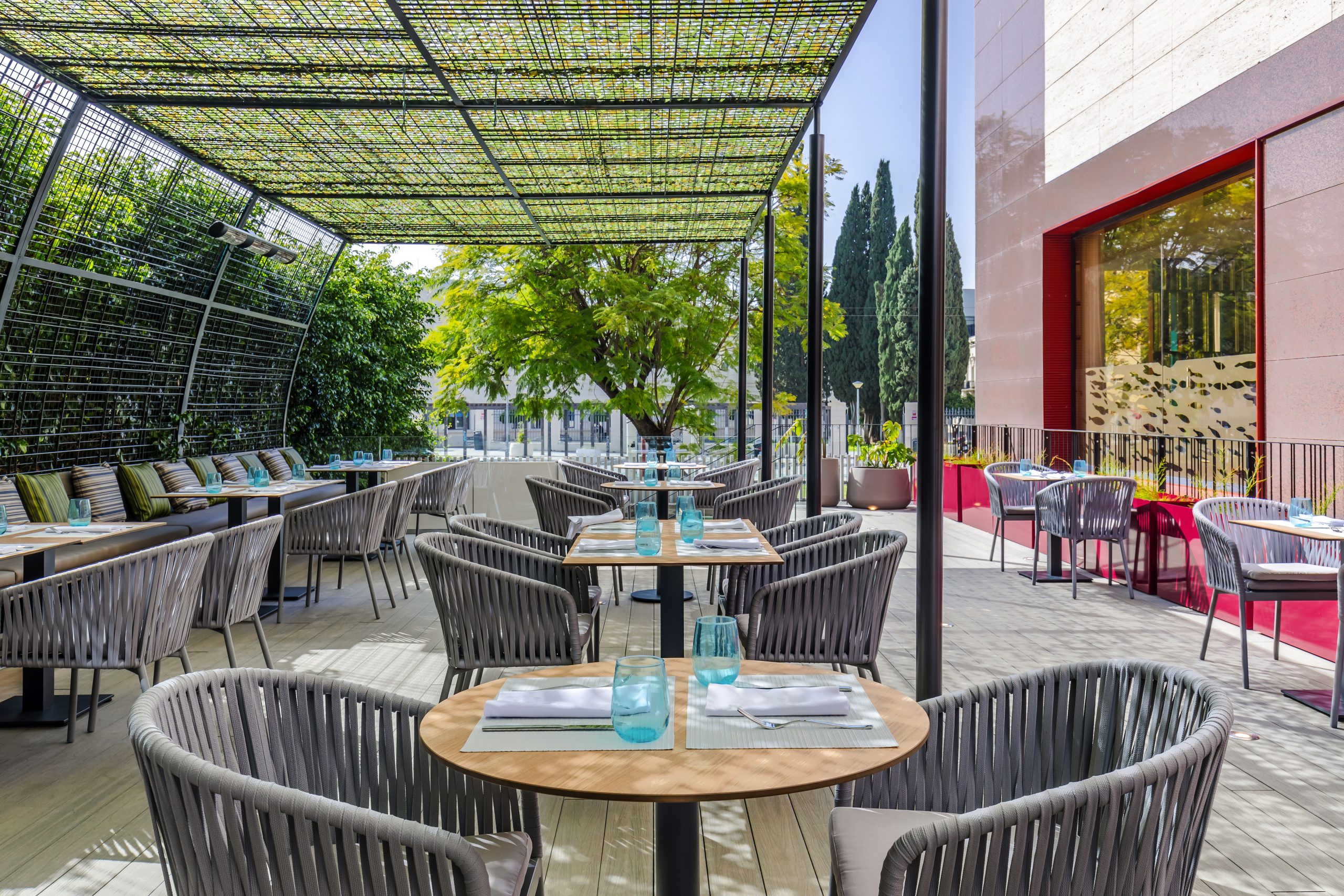After the capture of Seville by Ferdinand III of Castile in 1248, the Christians began using the city’s Great Mosque as a cathedral. They built the Chancel in the eastern-facing wall, thus changing its liturgical orientation from south (Muslim) to east (Christian), and the King ordered the construction of a Royal Chapel which, years later, would become his burial place. This arrangement lasted until the fourteenth century when, because of the building’s state of neglect, work began on building a genuine Christian cathedral. According to Seville’s oral history tradition, the canons of the time said, “Let us build a church so beautiful and so magnificent that those who see it finished will think we are mad.” The result was a Gothic cathedral that, following its consecration in 1507, was the largest in the world until the construction of St. Peter’s Basilica in the Vatican, and which remains to this day the largest Gothic church in the world. It has been designated a World Heritage Site (1987) and an Asset of Outstanding Universal Value (2010). However, its greatest symbol, La Giralda, was already here long before the arrival of the Christians; this famous bell-tower is none other than the minaret of the former mosque of the caliph Abú Yuqub Yusuf, built in 1182.
Related experiences
La Giralda, the Patio de los Naranjos and the ten doors: the Cathedral’s Arab vestiges
If you look very closely at La Giralda, you may have a feeling that you have seen it before. That is because this 97-metre Almohad tower is a twin of the minarets of Rabat and Marrakesh, both of which are still standing. The body of the tower, with its traditional Arab tracery, was topped (following the Christian Reconquest) with a bell-tower in the Renaissance style, on which sits El Giraldillo, a sculpture representing the triumph of the Christian faith. An essential part of any visit to the Cathedral is the climb up to the top of the tower to enjoy the privileged views over Seville.
Still outside the Cathedral, we come to the Patio de los Naranjos [Courtyard of Orange Trees], once the ablutions court of the Almohad mosque, and presided over by a fountain of Visigoth origin. Although the courtyard has undergone many changes over the years, it is still possible to make out its original structure, in which pointed iron archways were supported by pillars. This lovely rectangular courtyard, full of orange trees, has a pulpit from which holy men such as San Vicente Ferrer, San Francisco de Borja and San Juan de Ávila once preached. Here also is the Biblioteca Capitular y Colombina, which owes a large proportion of its collection to the bibliographical legacy of Ferdinand Columbus (Hernando Colón in Spanish), the son of the renowned sailor and celebrated cosmographer.
The Patio de los Naranjos can be accessed from inside the cathedral through the El Lagarto, La Concepción and El Sagrario doors (the latter leads from the Cathedral’s Sacrarium, a Baroque church which forms part of the whole), and from outside through the Puerta del Perdón, the oldest door of all and the only one which remains of the Almohad mosque.
Including those already mentioned, the Cathedral has ten entrances, the busiest being the Puerta del Príncipe, leading from the Plaza del Triunfo (to the south), and the Puerta de la Asunción ,the main entrance to the edifice, leading from the Avenida de la Constitución. On this same west façade, there can also be found the Cathedral’s two oldest doors, the Puerta del Bautismo and the Puerta del Nacimiento. The Puerta de Campanillas and the Puerta de Palos open onto the Plaza Virgen de los Reyes, with the Puerta de Palos being the door through which the Brotherhoods leave the Cathedral during the Semana Santa processions.
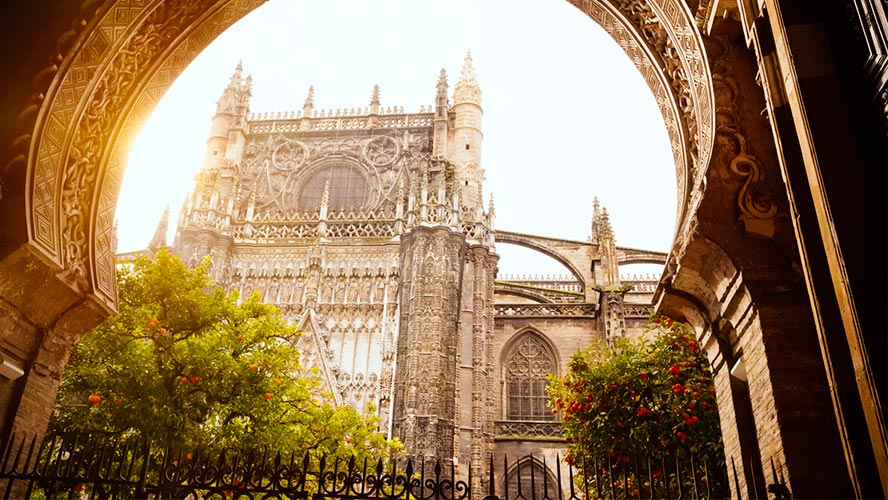
The tomb of Christopher Columbus, the High Altar and the Royal Chapel
There is no doubt that the Cathedral’s main tourist attraction is the tomb of Christopher Columbus. His remains were brought here in 1899, bringing to an end a drawn-out, wandering journey through Valladolid (where he died in 1506), the Monastery of la Cartuja de Sevilla, Santo Domingo and Havana. The casket, borne on the shoulders of four Kings of Arms in ceremonial dress (representing the historic kingdoms of Spain: Castile, León, Aragon and Navarre), is set on a raised pedestal facing the Puerta del Príncipe, inscribed with the words: “When the island of Cuba gained independence from Mother Spain, Seville obtained the casket containing the remains of Columbus, and the City Council erected this pedestal”.
In the sanctuary of the Cathedral, to the east, is the Royal Chapel, in which rest the remains of the Kings Ferdinand III of Castile, Alfonso X of Castile and Pedro I of Castile. It is worth pointing out that Seville Cathedral’s sanctuary is not the conventional apse shape, as the church’s floor plan is the rectangle previously occupied by the ancient mosque. This Chapel is not the one built on the orders of Ferdinand III in 1248, but a later version, which dates from 1579. On the High Altar waits the Virgen de los Reyes, Seville’s patron and perpetual mayoress, holding the keys to the city, its sceptre and gold medal. In the Crypt, where several members of the royal family are interred, there is an image of the Virgen de las Batallas, so called because apparently King Ferdinand III used to carry it into battle.
In the central nave are some of the most important features of the Cathedral, the outstanding one being the Chancel. This is dominated by the immense High Altar, designed by the Flemish sculptor Pedro Dancart in 1482, although completed over a period of a hundred years by various other artists and, with its height of nearly 30 metres, considered the largest in Christendom. Dedicated to the Assumption of the Virgin, the outstanding feature of the lower part is the thirteenth-century Gothic sculpture of the Virgen de la Sede, after whom the church is named, and on the top tier the famous Cristo del Millón, a twelfth-century Gothic work which remains from the early mosque-cathedral. This nave also contains the exquisite choir, with its Mudéjar-style seating, behind which there lies a sixteenth-century Renaissance grille, the retrochoir and the altarpiece, decorated with fifty-nine statues of saints, bishops and kings. Above are the two organs, rebuilt in 1901.
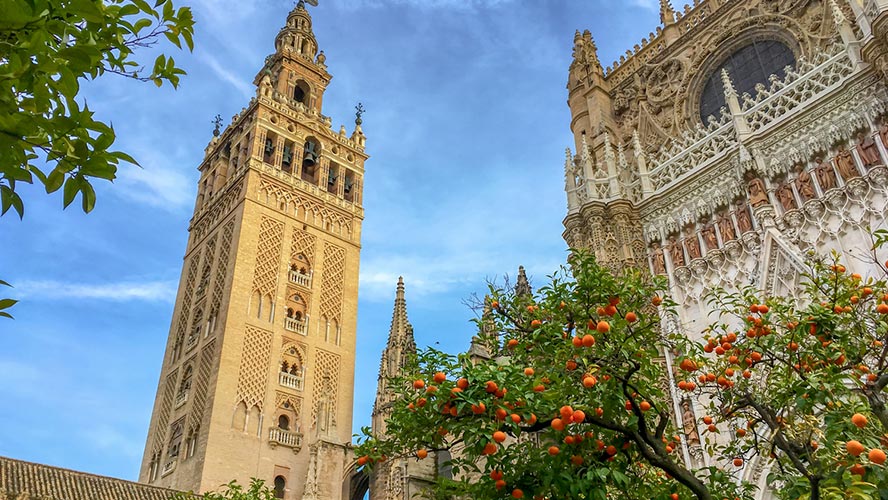
An ‘art museum’ in the Cathedral
The vast scale of the Cathedral means visiting it is rather like a visit to an art museum. The fact is that this place of worship contains 25 chapels adorned with works by the great masters of Spanish painting. This is certainly true of St Peter’s Chapel, whose magnificent seventeenth-century altarpiece is embellished with paintings by Francisco de Zurbarán and his disciples. Another painter whose work is heavily featured is the Seville painter Bartolomé Esteban Murillo. The cathedral contains, among others, his works La Visión de San Antonio y El bautismo de Jesús (in the Capilla Bautismal-San Antonio [Saint Anthony’s Baptismal Chapel]), La Inmaculada (in the Sala Capitular [Chapterhouse]) and Ángel de la Guarda (on the Altar del Ángel de la Guarda [Altar of the Guardian Angel]). Other art well worth seeking out includes the beautiful Renaissance paintings of Hernando de Esturmio (in the Capilla de los Evangelistas), the Apoteosis de San Francisco by Francisco de Herrera “El Mozo” [the Younger] (in the Capilla de San Francisco), and La Virgen de Belén by Alonso Cano (in the Capilla de Nuestra Señora de Belén). The list could easily be much longer.
Of historical rather than artistic interest, another essential stop on your tour is the Pendón de San Fernando, the historic flag with which Ferdinand III captured Seville in 1248, and on which the heraldic symbols of Castile and León were jointly displayed for the first time. The flag is displayed in a case opposite the entrance to the Iglesia del Sagrario.




































































